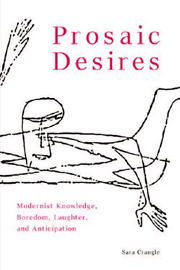2 - Haunted by Boredom
Published online by Cambridge University Press: 12 September 2012
Summary
In the midst of his knowledge- driven pursuit of dead ends, Stephen Dedalus argues, “The artist, like the God of the creation, remains within or behind or beyond or above his handiwork, invisible, refined out of existence, indifferent, paring his fingernails” (P 215). Stephen's spirit- artist creates in a rather clinical fashion, being both emotionally indifferent and tidy: “paring” connotes the removal of matter considered superficial and the act of trimming or making neat. Shortly after Stephen's very early morning departure from 7 Eccles Street, Bloom also removes a nail. While Bloom does not so much pare as tear, his more brutal process similarly engenders a creative act in which he plays a near- deific role. Noticing that his feet ache, Bloom takes off his shoes and socks; shortly after doing so, the narrator tells us that he “picked at and gently lacerated the protruding part of [his] great toenail” (837). This procedure is the culmination of a whole series of similarly restless activities: left alone, Bloom debates whether to watch the sunrise, wanders into his front room, lights incense, surveys the objects on his mantelpiece, his reflection in the mirror above it, and that of each of the twenty- two volumes on his bookshelves. Realizing he feels “inhibitory pressure” from his collar and waistcoat, he removes these items, as well as his trousers, shirt, and vest (835).
- Type
- Chapter
- Information
- Prosaic DesiresModernist Knowledge Boredom Laughter and Anticipation, pp. 71 - 103Publisher: Edinburgh University PressPrint publication year: 2010



